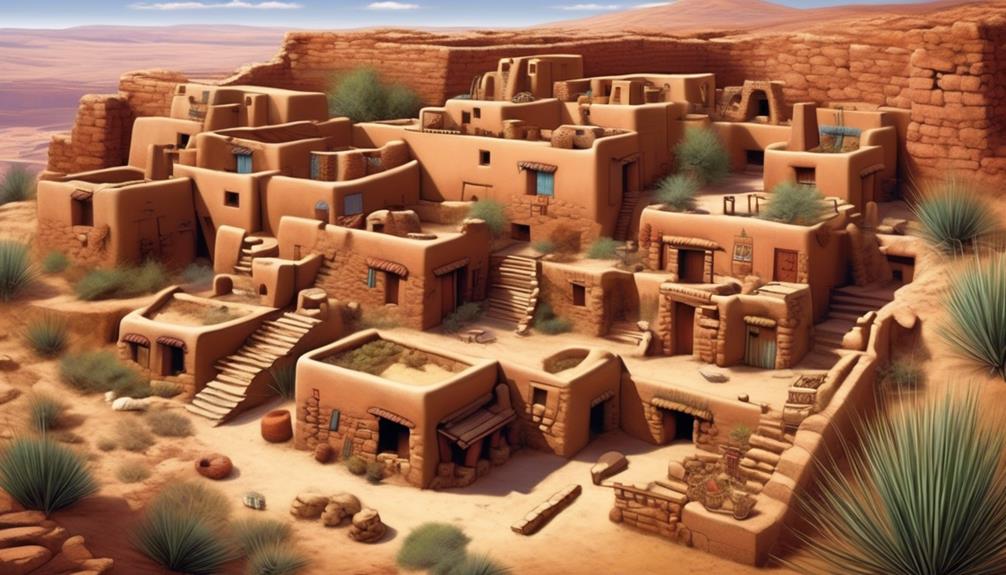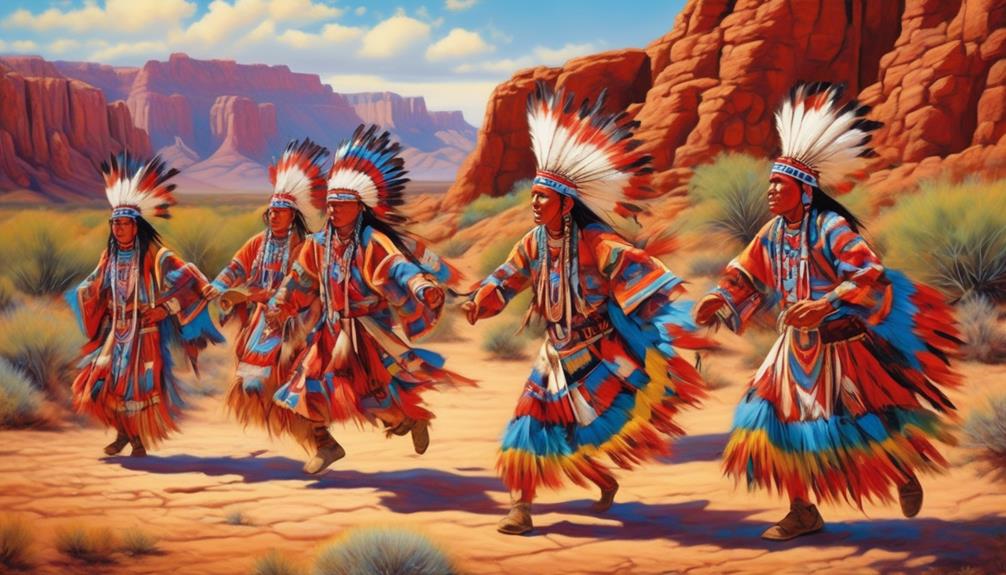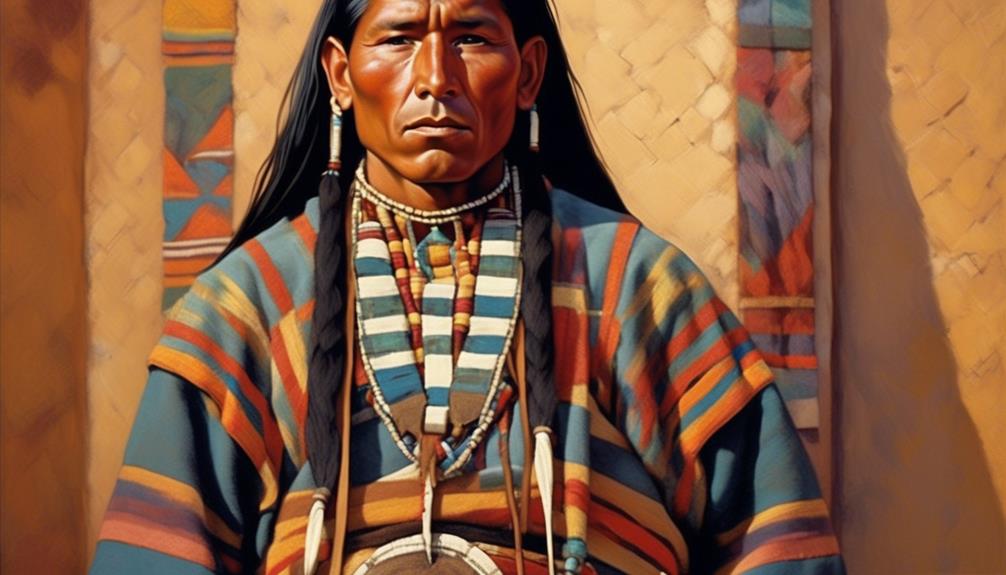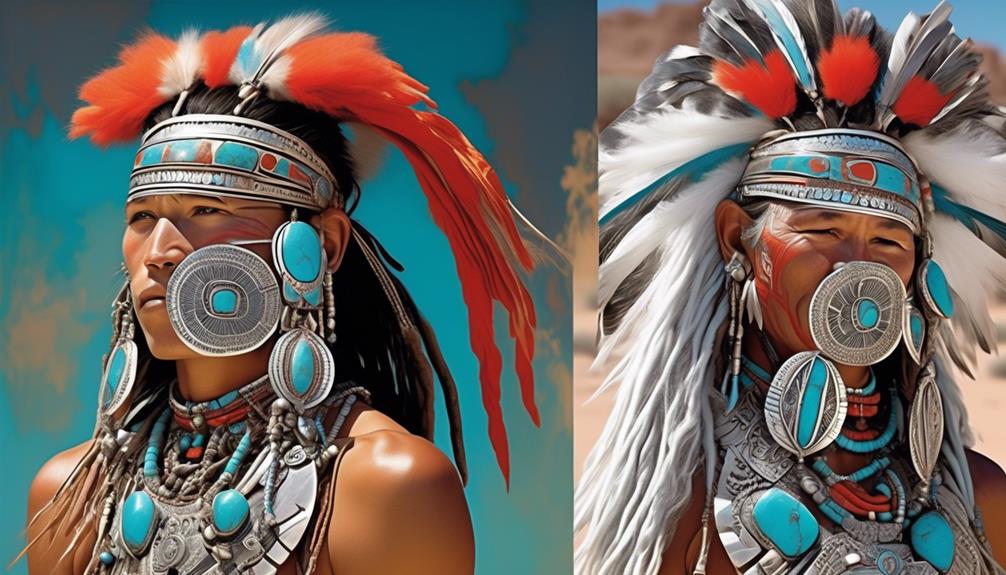Do you want to discover the complex and culturally important artifacts made by the Hopi tribe in the 1700s and 1800s?
The craftsmanship and artistry of the Hopi people during this time period are truly fascinating. From traditional pottery to symbolic jewelry, the Hopi tribe's creations offer a glimpse into their spiritual beliefs and unique cultural heritage.
But there's so much more to uncover about the techniques, materials, and significance behind these creations that have stood the test of time.
Key Takeaways
- Hopi pottery and basket weaving showcased exceptional craftsmanship and cultural significance.
- Natural materials like clay, volcanic ash, and natural pigments were used in both pottery-making and basket weaving processes.
- Hopi textiles incorporated intricate patterns and vivid colors, with traditional dyeing techniques and textile patterns holding deep symbolic meaning.
- Hopi jewelry embodied tradition, artistry, and cultural significance, with each piece serving as a tangible link to the tribe's heritage.
Traditional Hopi Pottery
In the 1800's and 1700's, the Hopi tribe created traditional pottery that served as both functional vessels and artistic expressions of their cultural heritage. The ancient techniques used by the Hopi potters have been passed down through generations, preserving the unique aesthetic and cultural significance of their pottery.
The process often begins with gathering natural materials such as clay, volcanic ash, and natural pigments from the earth. These materials are then hand-coiled to form the base shape of the vessel, a technique that has remained unchanged for centuries. The pottery is then painted with intricate designs using traditional symbols and motifs that hold deep spiritual and cultural meanings for the Hopi people.
In more modern times, the traditional techniques of Hopi pottery have been adapted to incorporate new tools and materials, allowing for greater precision and innovation while still honoring the ancient art form. This blend of ancient techniques and modern adaptations has enabled Hopi pottery to evolve while maintaining its cultural integrity.
The beauty and significance of Hopi pottery continue to captivate collectors and art enthusiasts worldwide, serving as a timeless link to the tribe's rich cultural heritage.
Intricate Basket Weaving
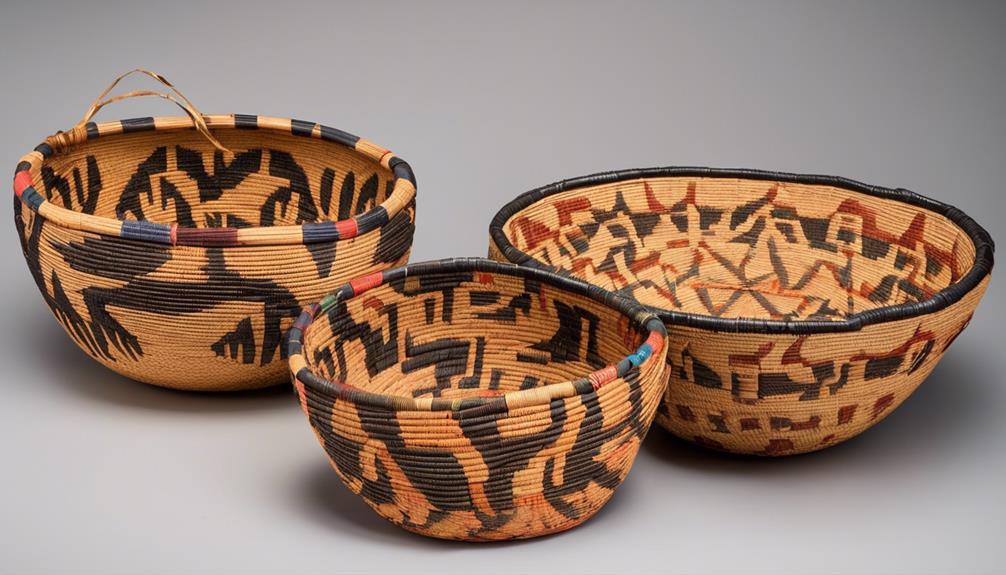
As we delve into the artistry of the Hopi tribe, the intricate basket weaving of the 1800's and 1700's emerges as a testament to their exceptional craftsmanship and cultural significance. The delicate, yet resilient, weaving process captures the essence of Hopi life, reflecting their deep connection to the land and the spiritual world.
The rhythmic sound of the weavers' hands moving in harmony with the natural materials evokes a sense of reverence for the ancient traditions and wisdom passed down through generations.
The intricate patterns and designs woven into each basket tell stories of the Hopi people, their history, and their relationship with the natural world, evoking a profound sense of cultural pride and identity.
The vibrant colors derived from natural dyes reflect the rich tapestry of Hopi life, celebrating the interconnectedness of all living beings and the cyclical nature of existence.
The use of indigenous techniques in basket weaving not only demonstrates the Hopi people's ingenuity and resourcefulness but also serves as a tangible link to their ancestors, fostering a deep sense of continuity and belonging within the community.
The art of basket weaving among the Hopi tribe transcends mere craftsmanship; it's a living expression of their cultural heritage and spiritual worldview.
Colorful Textile Artistry
The vibrant textiles created by the Hopi tribe during the 1800's and 1700's were a striking embodiment of their cultural artistry and storytelling traditions, weaving together intricate patterns and vivid colors to convey the essence of their heritage. The Hopi people used traditional dyeing techniques and intricate textile patterns to produce stunning pieces of fabric that held deep symbolic meaning within their culture.
| Textile Patterns | Dyeing Techniques | Symbolism |
|---|---|---|
| Katsina figures | Natural plant dyes | Spiritual significance |
| Geometric designs | Sun fading | Connection to nature |
| Animal motifs | Indigo dip | Representation of clan |
| Weather symbols | Resist dyeing | Reflection of beliefs |
The textile patterns often featured Katsina figures, geometric designs, animal motifs, and weather symbols, each holding specific cultural significance. The dyeing techniques employed were equally diverse, utilizing natural plant dyes, sun fading, indigo dipping, and resist dyeing to achieve vibrant and enduring colors. These textiles were not only a testament to the Hopi people's exceptional craftsmanship but also served as a means of preserving and passing down their cultural stories and traditions through generations.
Spiritual and Symbolic Jewelry

Exploring the rich tapestry of Hopi craftsmanship, the spiritual and symbolic jewelry of the tribe intertwines tradition, artistry, and cultural significance into captivating adornments.
The symbolic adornments crafted by the Hopi tribe hold deep spiritual and ceremonial significance, embodying the tribe's connection to the natural and spiritual worlds. These intricate pieces serve as more than just decorative items; they're imbued with historical significance, carrying the stories and traditions of the Hopi people through generations.
The artistry and precision in creating these ceremonial jewelry reflect the tribe's commitment to cultural preservation, ensuring that the knowledge and skills required to produce such pieces are passed down to future generations. The use of specific symbols and motifs in the jewelry communicates profound meanings, evoking a sense of reverence and awe.
Each piece of jewelry becomes a tangible link to the tribe's heritage, inviting us to appreciate the intricate craftsmanship and understand the spiritual depth encapsulated within these timeless adornments.
Craftsmanship Techniques and Materials
Utilizing intricate weaving techniques and locally sourced materials, the Hopi tribe's craftsmen skillfully create their ceremonial jewelry, infusing each piece with cultural significance and artistic mastery. The metalworking techniques employed by the Hopi artisans involve the skillful manipulation of silver and gold to produce innovative designs reflecting their deep connection to spiritual and natural elements. The use of natural dye sources, such as plant extracts and minerals, allows the weavers to imbue their textiles with a rich array of hues, each carrying its own symbolic meaning. These natural dye sources, combined with traditional weaving patterns, result in textiles that not only showcase the weavers' technical expertise but also convey ancestral narratives and tribal identity.
| Metalworking Techniques | Innovative Designs | Natural Dye Sources | Weaving Patterns | Locally Sourced Materials |
|---|---|---|---|---|
| Silver and gold manipulation | Reflecting spiritual and natural elements | Plant extracts and minerals | Symbolic and culturally significant | Reflecting tribal identity |
The Hopi craftsmen's dedication to preserving their heritage through these intricate processes and materials is evident in the timeless beauty and cultural depth of their creations.
Frequently Asked Questions
How Did the Arrival of European Settlers in the 1700's and 1800's Impact the Traditional Crafts of the Hopi Tribe?
The arrival of European settlers in the 1700's and 1800's had a significant impact on the traditional crafts of the Hopi tribe. The settlers' influence led to cultural changes, preservation challenges, and environmental adaptation for the Hopi artisans.
The introduction of new materials and techniques, as well as the demand for different types of crafts, altered the traditional methods and designs. These changes brought both opportunities and difficulties for the preservation of the tribe's artistic heritage.
What Role Did Trade and Interaction With Other Tribes Play in the Development of Hopi Crafts During This Time Period?
Trade and interaction with other tribes greatly influenced the development of Hopi crafts during the 1700s and 1800s. These exchanges brought new materials and techniques, enriching our traditional crafts.
However, the arrival of European settlers had a significant impact, leading to changes in production and designs. This period saw a dynamic evolution in our crafts, as they adapted to new influences and demands while maintaining their cultural significance.
Were There Any Specific Events or Cultural Changes That Influenced the Styles and Techniques of Hopi Pottery, Basket Weaving, and Textile Art in the 1700's and 1800's?
In the 1700's and 1800's, innovation and cultural exchange greatly influenced Hopi pottery, basket weaving, and textile art.
This period marked an artistic evolution as the Hopi adapted to environmental changes and interacted with neighboring tribes.
The influx of new ideas and techniques from trade and cultural exchange led to the development of unique styles and designs in Hopi crafts.
This showcased the tribe's ability to adapt and innovate in their artistic pursuits.
How Were Traditional Hopi Crafts Used in Everyday Life During the 1700's and 1800's, and Were They Primarily for Practical or Ceremonial Purposes?
We used traditional Hopi crafts for both practical and ceremonial purposes during the 1700's and 1800's.
Although some may argue that the impact of these crafts was mainly ceremonial, they were integral to everyday life. Pottery, basket weaving, and textile art served practical functions like food storage and clothing.
The preservation challenges and social adaptation have shaped the ongoing significance of these crafts in Hopi culture.
Did the Hopi Tribe Face Any Challenges in Preserving Their Traditional Crafts During the 1700's and 1800's, and How Did They Adapt to Changing Social and Environmental Conditions?
We faced significant challenges in preserving our traditional crafts during the 1700's and 1800's. Social changes and environmental conditions forced us to adapt. We had to find new ways to maintain our craft traditions amidst these challenges.
It was a struggle, but we persevered, finding innovative solutions to ensure the preservation of our craft heritage. Our ability to adapt to changing conditions was crucial in keeping our traditional crafts alive.
Conclusion
In the 1700's and 1800's, the Hopi tribe crafted traditional pottery, intricate baskets, colorful textiles, and spiritual jewelry using age-old techniques and materials. These beautiful creations weren't only functional, but also rich with symbolism and spiritual significance.
The craftsmanship of the Hopi people during this time period was truly remarkable, and their artistry continues to be celebrated and admired today. It's like they were the original 'DIY' experts, creating stunning works of art with their hands and hearts.
Mary is a passionate writer who brings creativity and a fresh perspective to our team. Her words have the power to captivate and inspire, making her an essential contributor to our content. Mary’s commitment to storytelling and dedication to promoting Indigenous culture ensures that her work touches the hearts of our readers. We’re fortunate to have her as part of our team.



